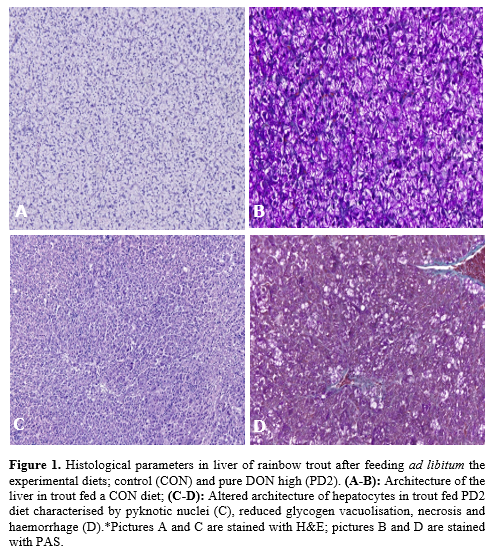TIME- AND DOSE-DEPENDENT EFFECTS OF DIETARY DEOXYNIVALENOL (DON) IN RAINBOW TROUT Oncorhynchus mykiss
Introduction
Lately, the aquaculture industry has shifted towards the formulation of more sustainable diets, characterized by a higher inclusion of plant-based ingredients - even in feeds for carnivorous fish species like salmonids. Because plant-based ingredients are susceptible to fungal growth, the risk of mycotoxin contamination has been increased in aquaculture. In combination with climate change, fungal growth and distribution might be affected and lead to uncertain mycotoxin profiles in feeds. A recent survey in aquafeeds highlighted deoxynivalenol (DON) as the most potent toxin for European aquaculture. The same study with a meta-analysis showed that DON reduces fish productivity due to impaired feed intake and recognized rainbow trout as the most sensitive fish species. Previous experiments in rainbow trout were performed within ad libitum exposure to DON, either in the natural form (coming from naturally contaminated ingredients) or pure (commercial powder). However, ad libitum exposure reduces the feed intake masking the effects on growth related to the toxin itself. Also, pure DON has less severe effects than the natural source, since in the last case a synergism might exist due to the co-occurrence of different toxins. Therefore, the current study aimed to elucidate the effects of two different types of DON (natural or pure) on growth performance and liver histopathology. Firstly, rainbow trout were fed restrictively and equally the experimental diets for six weeks to detect the potential effects of DON related to the toxin itself and not due to differences in feed intake. An intermediate sampling point was implemented after a week of feeding to investigate whether DON effects change over time. Finally, the experiment continued with two weeks of ad libitum exposure that could reveal potential DON impact on the feed intake capacity.
Material and methods
A feeding experiment was performed with rainbow trout fingerlings (8 g) to evaluate the effects of DON at realistic doses (up to 1600 µg/kg) on growth performance and liver histopathology. Thirty fish were randomly assigned to one of the five different dietary treatments with three replicates each: (1) control (CON) diet (DON < 100 µg/kg), (2) naturally DON-contaminated diet (ND1) with 700 µg/kg feed, (3) and 1200 µg/kg (ND2), (4) pure DON-contaminated diet (PD1) with 800 mg/kg, and (5) 1600 µg/kg (PD2). The feeding trial lasted eight weeks and included two feeding regimes: six weeks of restrictive feeding (12 g/kg MBW) followed by two weeks of ad libitum feeding. At the end of each feeding period, batch weighting was performed to calculate growth performance parameters. Initial and final crude protein (CP) and gross energy (GE) body composition at the end of the restricted period (day 40) were determined from 20 fish and five fish/tank, respectively. CP was calculated based on nitrogen x 6.25 using the Kjeldahl method, and GE measured with the adiabatic bomb calorimeter method. Two fish per tank or six per treatment (CON, ND2 and PD2) were sampled for histological assessment at two different time points of restricted feeding period (day 6 and 40). At the end of the satiation feeding period, growth and the feed intake capacity was measured, and liver samples were collected for histological assessment. Liver sections were stained with Periodic acid-Schiff’s (PAS) to detect lipid-type and glycogen-type vacuolisation, and with haematoxylin and eosin (H&E) to evaluate pathological parameters based on a quantitative scoring system. The IBM Statistical Package for the Social Sciences (SPSS) program (v 23.0; New York, NY, USA) was used to perform the statistical analyses.
Results
Restrictive exposure to DON for six weeks did not affect the growth performance of trout but reduced retained protein in fish treated with ND2 and PD2. The last finding supports the hypothesis of DON inhibiting protein synthesis or increasing maintenance requirements and leads to increased protein catabolism and impaired nutrient utilisation. Liver histological assessment revealed altered nuclei characteristics and haemorrhages in the high DON-treated fish (ND2/PD2) after six days of restrictive DON exposure, but effects faded out over time (40 days). The latter may imply adaptation mechanisms in rainbow trout to recover after exposure to a certain DON amount. However, when ad libitum DON exposure was applied, hepatic damage aggravated: reduced glycogen vacuolisation, altered nuclei characteristics, necrosis and haemorrhages incidences were noted (Fig 1). Hepatic damage was more severe in PD2 than ND2 treatment, which might be explained by the higher DON content (1600 µg/kg vs 1200 µg/kg). Surprisingly, ad libitum exposure did not affect the feed intake capacity; maybe because rainbow trout had been exposed earlier to a restrictive exposure to DON for six weeks they had adapted. Finally, ad libitum exposure led to reduced body weight gain and altered feed efficiency in ND2 and PD2 treatments. The latter observation suggests the feeding regime determines the actual amount of ingested DON and the severity of the effects on rainbow trout.
